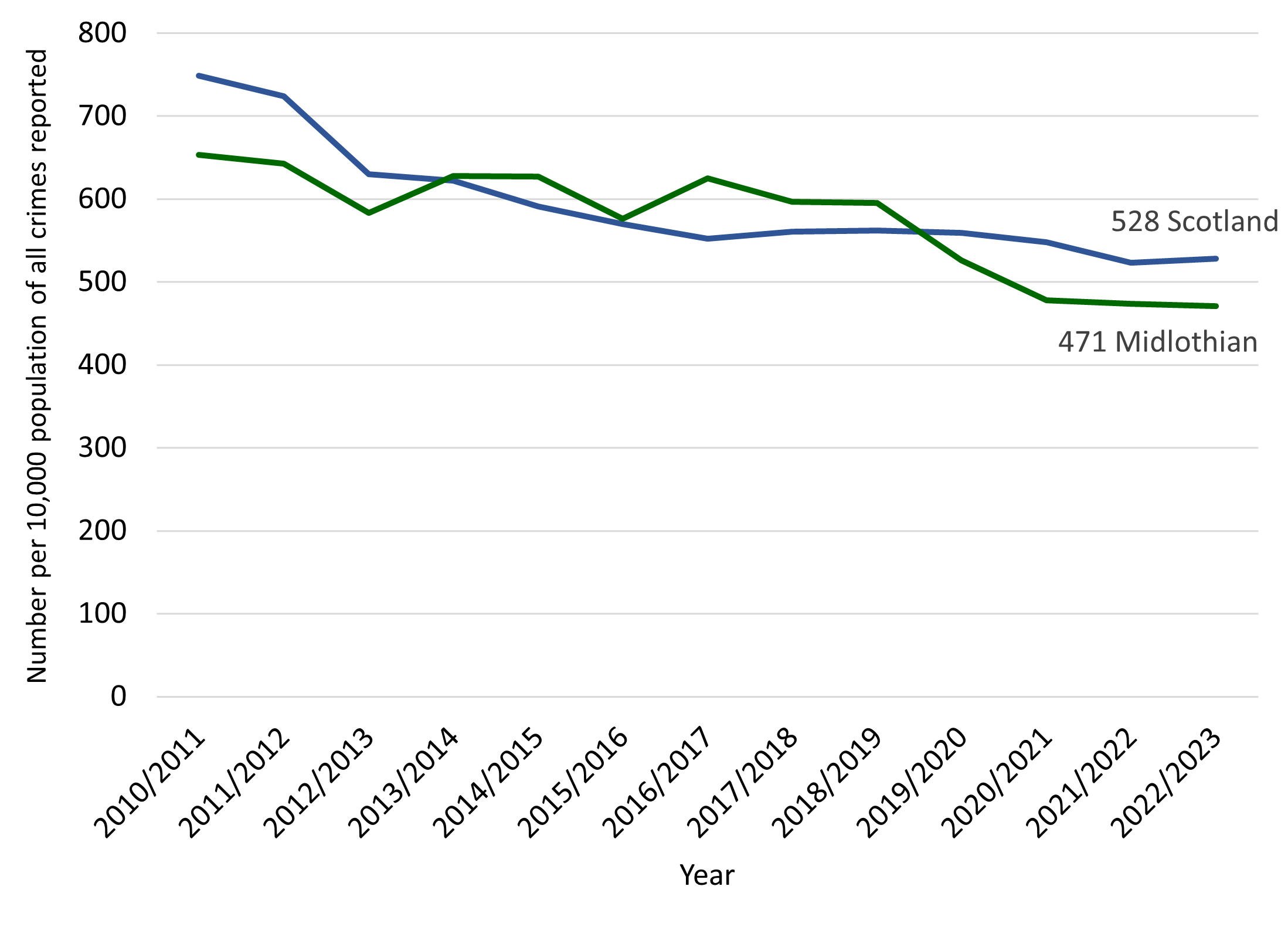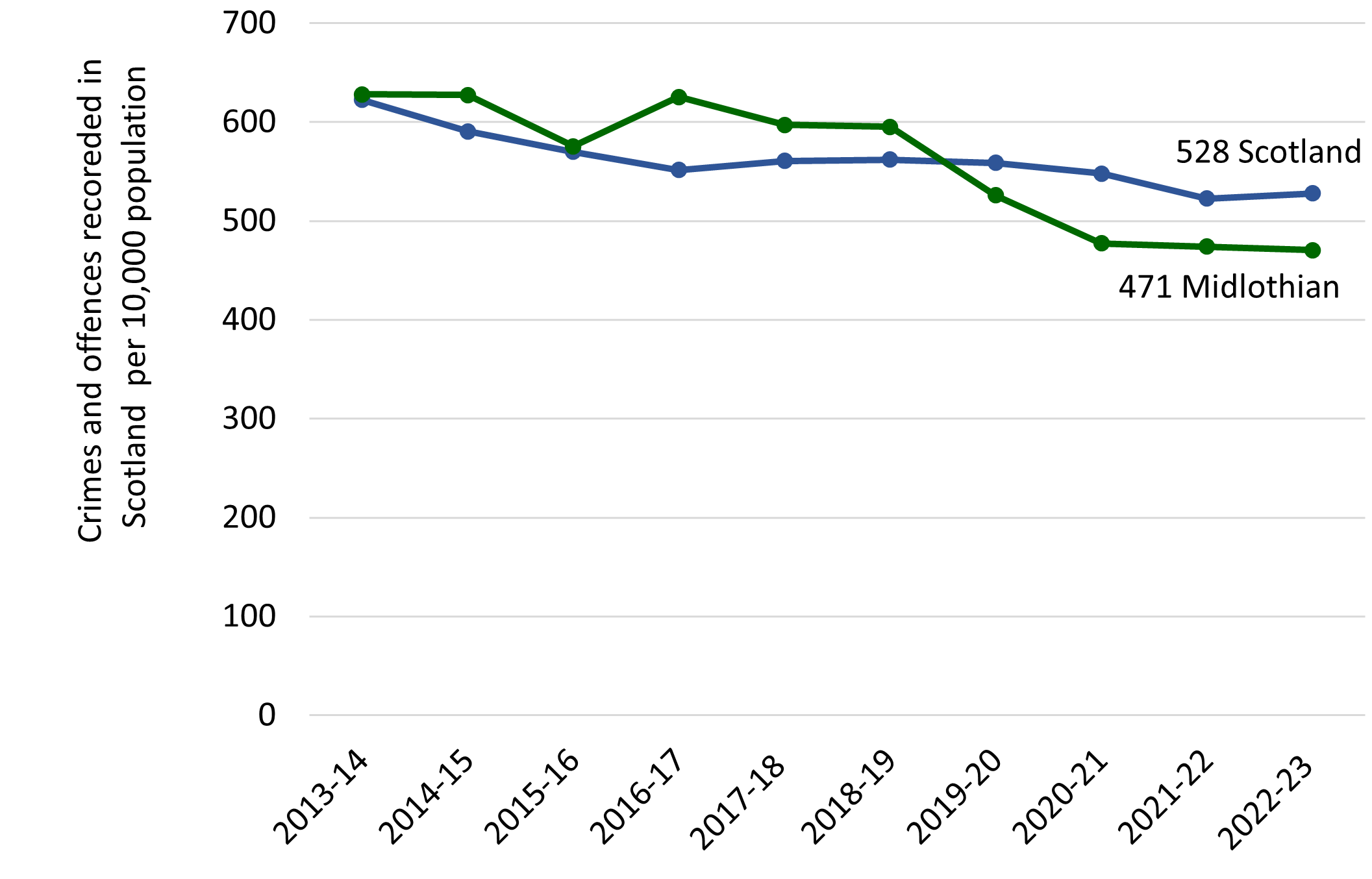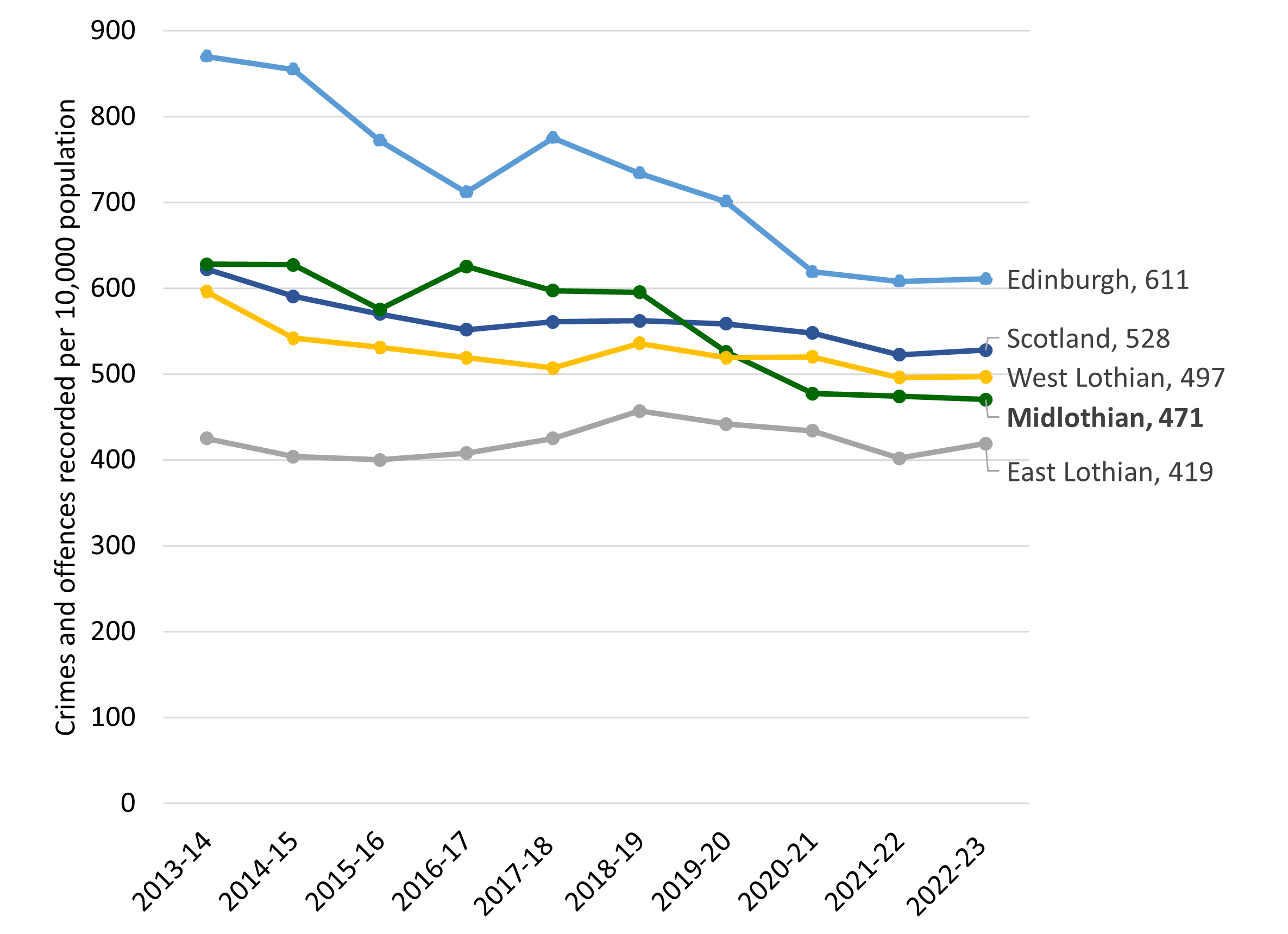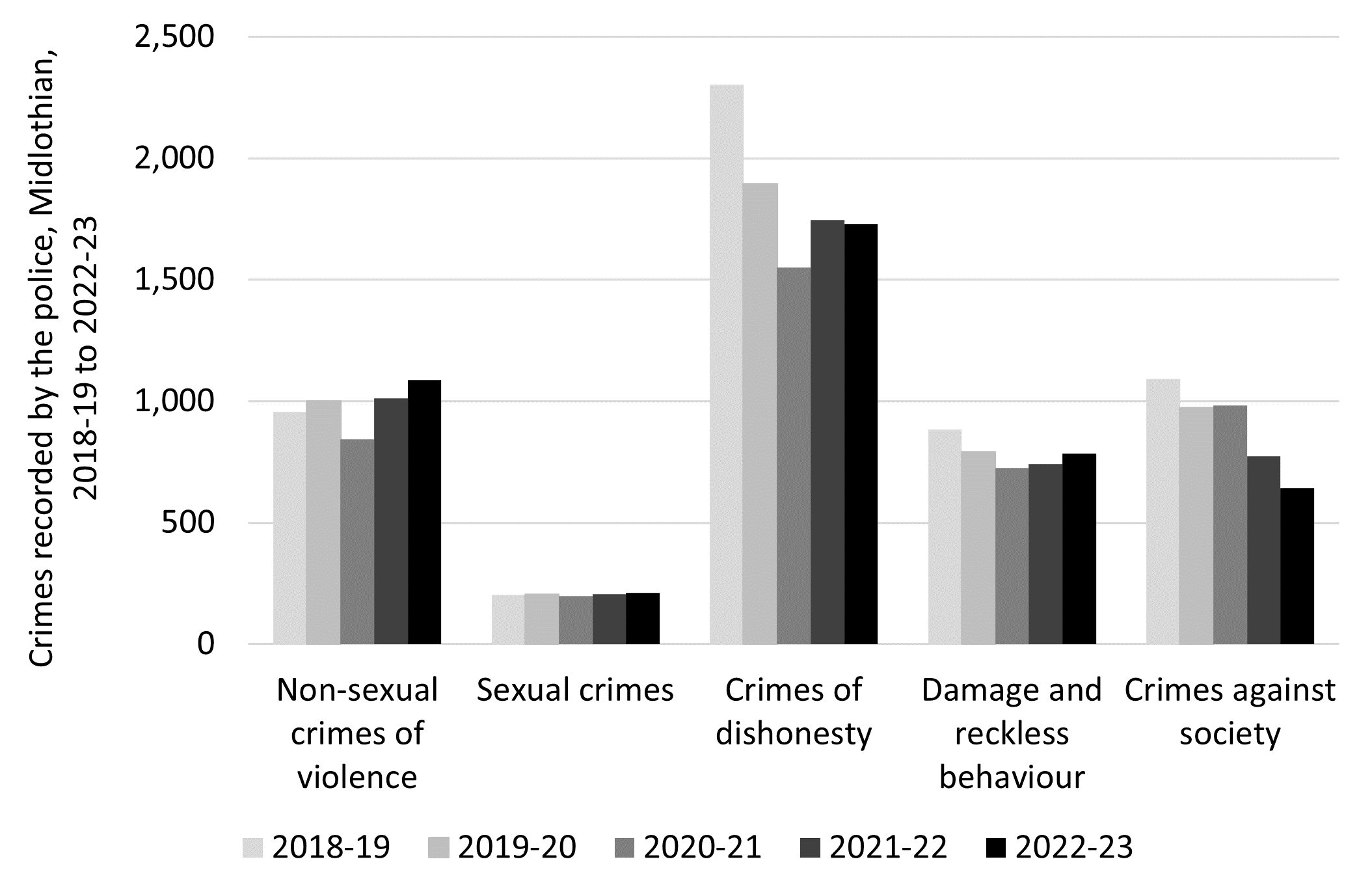Community Justice - Data
What you told us
What the data tells us
Community Justice is the prevention and reduction of offending by addressing the underlying causes. It is concerned with making a positive change for those who have committed offences, their families, and victims of crime.
Number and rate per 10,000 population of all crimes recorded by the police
Data source: Scottish Government

A three-year profile analysis of offenders in Midlothian identified characteristics which include:
- The highest proportion of people involved in offending were resident in Dalkeith/Woodburn.
- Over two thirds left school at the minimum leaving age without further formal education.
- 38% had financial problems.
- A quarter had accommodation problems.
- 57% had a history of alcohol misuse. 48% had a history of drug problems
Scottish data shows a strong association between mental health issues and offending. Two in three women prisoners suffer from depression, and just under half of female prisoners have attempted suicide. Concerns are raised around the proportion of prisoners struggling to form positive attachments; 46% of prisoners reported they rarely/never ‘felt interested in other people’, 48% reported they rarely/never ‘felt loved’ and 49% reported they rarely/never ‘felt close to other people. It is estimated that the prevalence of learning disabilities among offender populations is much higher than the general population with around 20% to 30% of offenders within the criminal justice system affected by a learning disability.
There is a high correlation between being in prison and income inequality, social mobility, teenage births, and high levels of obesity and smoking. Domestic violence is also associated with offending behaviour, nationally 43% of young offenders report witnessing violence between their parents or guardians as a child.
Scottish data also shows a strong relationship between gender and community Justice. Males accounted for 82% of all people convicted in 2018/19 but represented a higher proportion of all custodial sentences (91%) totalling 11,092 men. By contrast women accounted for 18% of people convicted compared to a lower proportion for custodial sentences (9% of custodial sentences). Males also have higher reconviction rates and a higher average number of reconvictions per offender than females.
Types of Crime:
When describing crime the following groups are used:
- Group 1: Non sexual crimes of violence;
- Group 2: sexual crimes;
- Group 3: crimes of dishonesty;
- Group 4: damage and reckless behaviour
- Group 5: crimes against society (these do not include Coronavirus restrictions crime, of which there was 151 in 2020/21 & 14 2021/22).
Recorded crime covers crimes which are recorded by the police. Not all crimes are reported to the police, which means they are not recorded. Recorded crime does provide a measure of criminal activity seen in the community.
The most common crime type recorded was ‘Dishonesty crime’ - includes housebreaking, theft of motor vehicles, shoplifting, fraud, and other thefts.
Police recorded 4455 Group 1-5 crime in Midlothian in 2022/23, a decrease of 34(-1%) from the previous year (Midlothian Profile 2022).
Recorded crimes in 2016/17 were highest over a 10-year period with the longer-term trend (ten years) is a decline in crimes recorded.
Crimes and offences recorded per 10,000 population, Midlothian and Scotland, 2013-14 to 2022-23.
Data source: Recorded Crime in Scotland, Scottish Government

The rate of crimes (Group 1-5) per head of population has decreased over the last six years, with a current rate of 471 crimes per 10,000 population.
Midlothian has moved to the second lowest local authority in the Lothian area for recorded crimes group 1-5 crimes per head of population.
Crimes and offences recorded per 10,000 population, Local Authorities in Lothian and Scotland, 2013-14 to 2022-23
Data source: Recorded Crime in Scotland, Scottish Government

The percentage of crimes/offences cleared up by the police (i.e., where there is a sufficiency of evidence under Scots law, to justify consideration of criminal proceedings) was 45.7%. This is below the previous year when 50.7% of crimes were detected. This is also below the three- and five-year average (51.6% and 53%).
Group 1-5 crimes recorded by the police in Midlothian, 2018-19 to 2022-23
Data source: Recorded Crime in Scotland, Scottish Government

During the period of 2021/22 there were 1158 incidents of domestic abuse recorded by Police in Midlothian showing a slight decrease of 49 incidents from 2020/21. This was a decrease of 4.05% compared to the previous year and 2.68% decrease from the three-year average. In terms of crimes/offences, just over one third (38%) of incidents resulted in a crime report – a small increase from last year and the three-year average (35% and 36% respectively).
Number of incidents of domestic abuse recorded by police.
Data source: Domestic abuse: statistics recorded by the police in Scotland, Scottish Government
| 2019/20 | 2020/21 | 2021/22 | |
|---|---|---|---|
| Number of incidents | 1206 | 1207 | 1158 |
| Rate of incidents per 10,000 population | 130 | 130 | 122 |
Incidents of domestic abuse and percentage which resulted in a crime report.
Data source: Domestic abuse: statistics recorded by the police in Scotland, Scottish Government
| 2017/18 | 2018/19 | 2019/20 | 2020/21 | 2021/22 | |
|---|---|---|---|---|---|
| Number of incidents | 987 | 1179 | 1206 | 1207 | 1158 |
| % of Incidents which result in a crime report | 41% | 33% | 34% | 35% | 38% |
Page updated August 2024
